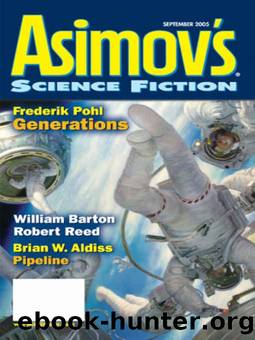Asimov's Science Fiction 2005-09 by Dell Magazine Authors

Author:Dell Magazine Authors [Authors, Dell Magazine]
Language: eng
Format: epub
Tags: Magazine, 2012
Publisher: Dell Magazines
Published: 2010-07-03T04:00:00+00:00
Copyright © 2005 by William Barton.
Author's Note:
As with most so-called Alternate History, everything in this story is âpossibly true,â in the sense that at least the kernel of the thing existed in our real timeline. How these things would have played out is a matter of conjecture, bordering on fantasy.
"Harvest Moonâ is based on a 1959 Army feasibility study called Project Horizon, initially known as Project Mountain Top, which called for the construction of a space station and permanent moonbase in the mid 1960s, using technology then under development. It proposed using a conceptual Saturn vehicle, consisting of a Saturn C-1 first stage, with a Titan ICBM booster as the second stage, and a Centaur third stage to land small cargo packages on the Moon, with men following in a two-man vehicle using the Earth-orbit rendezvous technique. It would've required hundreds of launches, at an average rate exceeding sixty per year. And, oh yes, Horizon included a return capability from the start. There was also a real Project Adam, proposed by the Army Ballistic Missile Agency, and it sort of really flew, as the two Mercury-Redstone suborbital missions of 1961.
The real Project Gemini was remotely descended from the Air Force's Project MISS of the 1950s, MISS standing in Phase I for Man in Space Soonest, and in Phase II for Man in Space Sophisticated. In the story, Gemini A is our Gemini, which flew ten missions in 1965-1966. Gemini B is based on the Manned Orbiting Laboratory, whose hardware was actually built, but never flown. The real MOL was considerably heavier than what I describe here. Gemini C and M are the B variant stripped of reentry hardware and mounted on a hypothetical lunar descent stage. Gemini T is based on the âBig Geminiâ proposal put forward when it looked like Apollo might never fly. Gemini R is a hodge-podge of MOL and Apollo LM hardware.
I think everyone of a certain age will remember the Air Force's X-20 DynaSoar, a reusable spacecraft proposed to be launched atop a Titan II ICBM. There was an unmanned version called Asset that really flew, and these, along with various lifting-body testbeds, were ancestral to the Space Shuttle.
The Titan IIIZ of the story is based on the Titan IIIC, a Titan II ICBM with two strap-on segmented solid rocket motors, and a transtage whose engines were the same ones used in the Apollo Lunar Module. The IIIZ comes from a proposal to build a much bigger version, by scaling the Titan tankage from ten to fifteen feet diameter, and bolting on four solids. The US really did build nuclear rocket engines under the aegis of Project NERVA. The Rover 1 engine, with 75,000 lbs. thrust, was ready for flight testing in 1973, but the program was canceled.
In our timeline, Project Apollo succeeded partly because a certain German engineer politicked to have his brainchild become the American space program, but mostly because it was associated with a certain American president who was murdered in public.
The
Download
This site does not store any files on its server. We only index and link to content provided by other sites. Please contact the content providers to delete copyright contents if any and email us, we'll remove relevant links or contents immediately.
Roadside Picnic - Tale of the Troika by Boris Strugatsky & Arkady Strugatsky(405)
Uncanny Magazine Issue 27 by Lynne M. Thomas(305)
Galaxy's Edge Magazine by C.J. Cherryh(297)
Ciaphas Cain: The Anthology by Sandy Mitchell(295)
Uncanny Magazine Issue 47 by Lynne M. Thomas(294)
Uncanny Magazine Issue 28 by Lynne M. Thomas(280)
Uncanny Magazine Issue 29 by Lynne M. Thomas(277)
Uncanny Magazine Issue 7 by Lynne M. Thomas(270)
Uncanny Magazine Issue 9 by Lynne M. Thomas(270)
Uncanny Magazine Issue 10 by Lynne M. Thomas(266)
Uncanny Magazine Issue 11 by Lynne M. Thomas(266)
Uncanny Magazine Issue 17 by Lynne M. Thomas(264)
Uncanny Magazine Issue 19 by Lynne M. Thomas(260)
De Wapensmeden by A.E. van Vogt(259)
Uncanny Magazine Issue 22 by Lynne M. Thomas(255)
Uncanny Magazine Issue 2: JanuaryFebruary 2015 by unknow(254)
Uncanny Magazine Issue 8 by Lynne M. Thomas(250)
A. R. Yngve(247)
Uncanny Magazine Issue 13 by Lynne M. Thomas(247)
